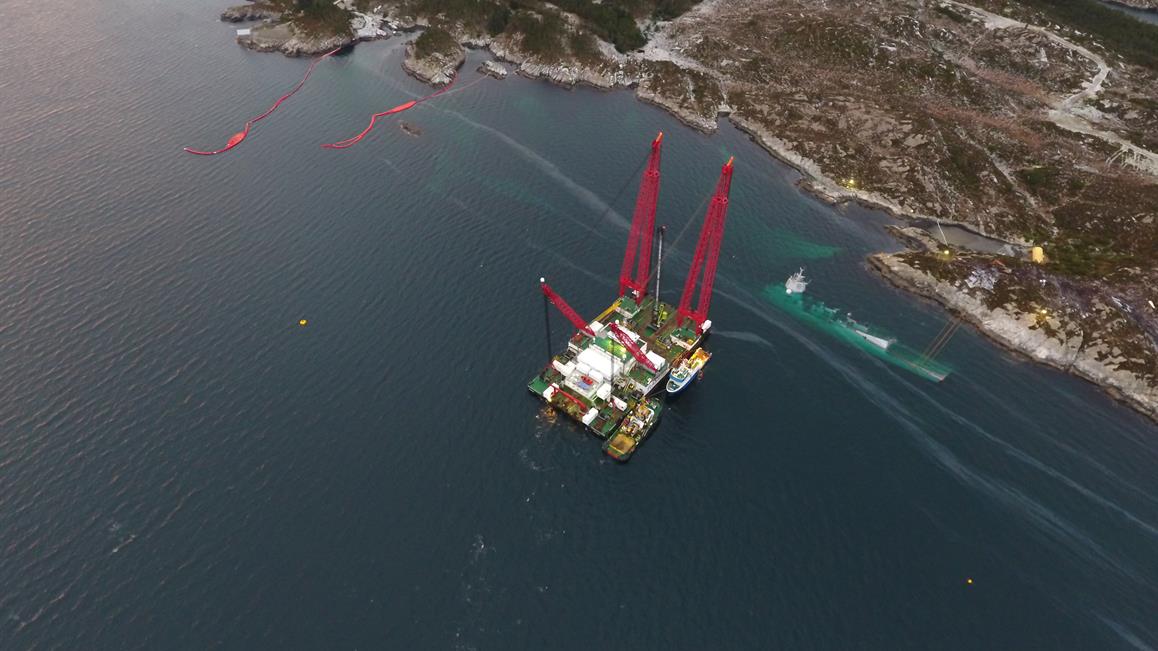Wrecked Frigate's Crew Thought Oncoming Tanker was Fixed Object
The collision between the Norwegian frigate Helge Ingstad and the Aframax tanker Sola TS was caused in part by the Ingstad bridge team's impression that Sola TS was a fixed object, according to an initial report by the Accident Investigation Board Norway (AIBN). The agency's analysis is preliminary and will be updated once its investigation concludes.
In the early hours of November 8, the Ingstad was inbound along the Hjeltefjorden on the approaches to Bergen. She was nearing the Sture oil terminal, where Sola TS was in fully laden condition and preparing to depart. The watch on the Ingstad changed at 0345, and the incoming watch believed that the Sola TS' decklights were part of the well-lit terminal.
At 0345, Sola TS notified the Fedje VTS station that she was departing the pier. She turned through about 180 degrees to port in order to set an outbound course of 350 degrees. Her crew left the deck lights on after they departed the terminal - making it difficult to detect her navigation lights from afar, and potentially contributing to the Ingstad bridge team's continued belief that Sola TS was part of the terminal.
At 0357, the pilot aboard Sola TS detected the Ingstad's radar signature, making 17 knots on a southbound course. As the frigate was not transmitting AIS, Sola TS had to ask the VTS operator for the warship's identity. The VTS center did not know, and the bridge team on Sola TS tried to contact the unidentified target by other means - including signal lamp, a legacy communications method that only sees frequent use aboard naval vessels. Sola TS' pilot also ordered a 10 degree course change to starboard.
At 0400, Fedje VTS informed Sola TS that the target could be the Helge Ingstad. The Sola's pilot then called the Ingstad and requested that she turn to starboard immediately. The Ingstad's watchstanders responded that they could not make a starboard turn until they had passed the "object" that they perceived on their starboard side (the tanker).

Video still from VTS tracking in the moments before the collision; the Ingstad is the unnamed radar target at top left (social media)
VTS data shows that throughout this evolution, Sola TS was transmitting an AIS signal with her position, speed and heading, and was presenting a radar signature consistent with a large merchant vessel in motion. She was making seven knots.
Shortly after 0400, the Ingstad closed to within two cables of the Sola TS. Both the Sola TS' pilot and the VTS center called on the frigate to turn immediately. At the last moment, the Ingstad's bridge team executed a maneuver, but too late to avert an accident, and the two vessels collided.
Post-accident photos show that the 140,000-ton displacement Sola TS sustained superficial damage to her starboard side anchor guard and a small hole above the waterline on her starboard bow. The 5,000-ton displacement Ingstad suffered extensive hull damage along her starboard side, lost propulsion and steering control, experienced flooding in three compartments, and quickly drifted aground. Eight personnel were injured.
As Ingstad's crew attempted to control the flooding, they initially believed that they would be able to save their ship. The Ingstad was designed to survive flooding in the affected compartments, so long as it did not spread. However, the water quickly penetrated past apparently undamaged watertight bulkheads and into adjacent spaces, and the Ingstad's crew determined that she was in danger of sinking. The master ordered the crew to abandon ship, and the Norwegian Navy took the decision to push the vessel onto shore in order to prevent her from settling beneath the water.
The attempt to minimize harm to the vessel was ultimately unsuccessful: over the following five days, she gradually sank until only her radar tower protruded. Salvage efforts are ongoing.

Image courtesy Forsvaret
Damage control questions
In addition to its report, AIBN issued a warning bulletin to the Norwegian Navy and to the Ingstad's builder, Spanish yard Navantia, over apparent issues related to the vessel's survivability.
The initial flooding occurred in the aft generator room, one crew quarters compartment and one stores room. Shortly after, the crew found that water was spilling from the aft generator room into the gear room through the vessel's hollow propeller shafts. The gear room was quickly filling, and the water soon spilled through stuffing boxes in the gear room's bulkheads into the fore and aft engine rooms. With flooding in additional compartments, the crew had to prepare for evacuation.
“This [vulnerability] must be assumed to also apply to the other four Nansen-class frigates," AIBN concluded. “It cannot be excluded that the same applies to vessels of a similar design delivered by Navantia, or that the design concept continues to be used for similar vessel models. The AIBN assumes that its findings are not in conformity with the required damage stability standard for the Nansen-class frigates.”
Navantia has produced several designs similar to the Nansen-class, which is based on the Spanish Navy's F100 series. An enlarged version of the F100, the Hobart-class destroyer, is in service with the Royal Australian Navy. Navantia and Bath Iron Works have also submitted a joint proposal for the U.S. Navy's FFG(X) competition with a design based on the F100.
In a statement to media, Navantia said that it "will analyze all the possibilities," and noted that AIBN's findings "are concluded from a very preliminary investigation.”
